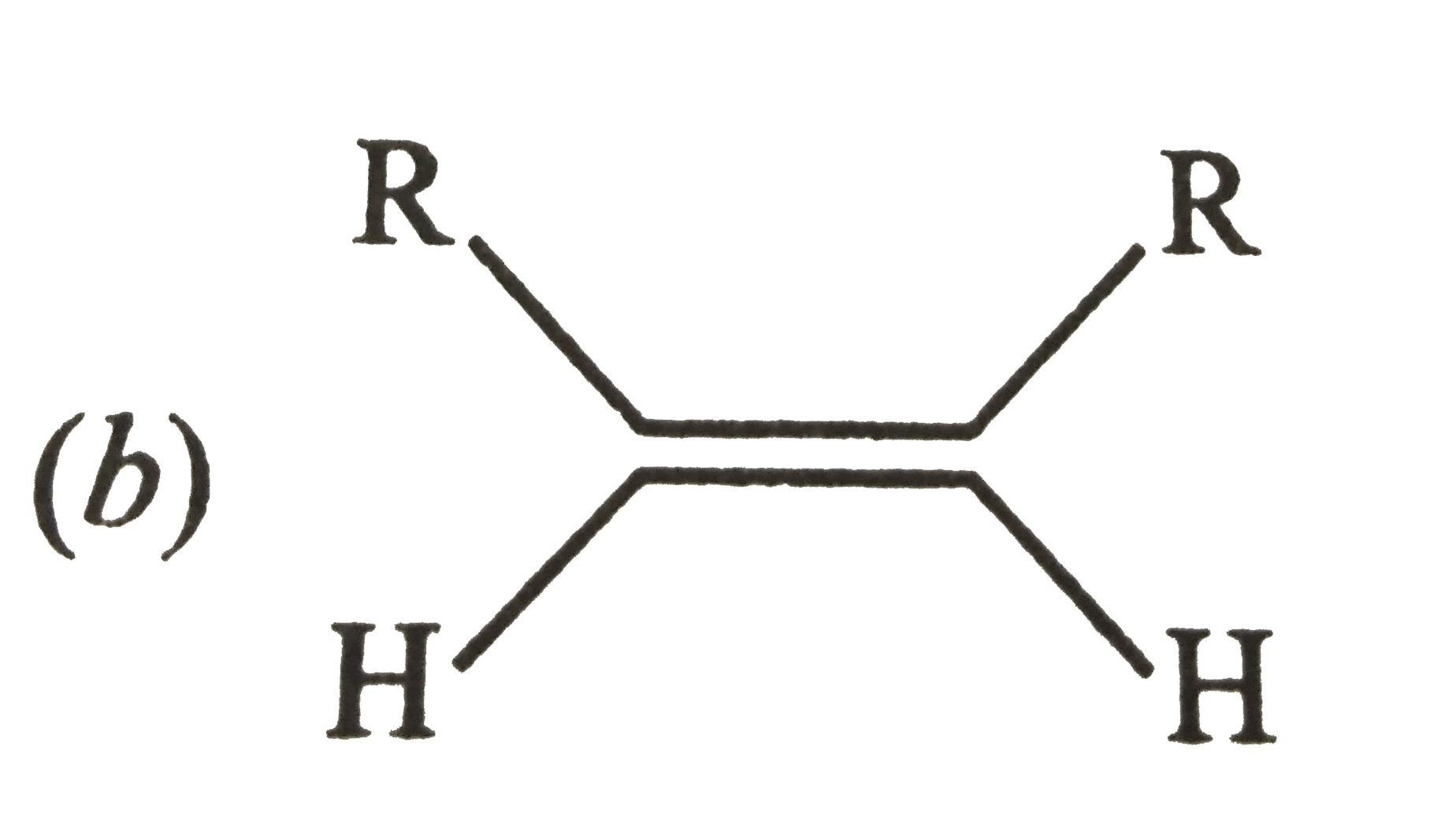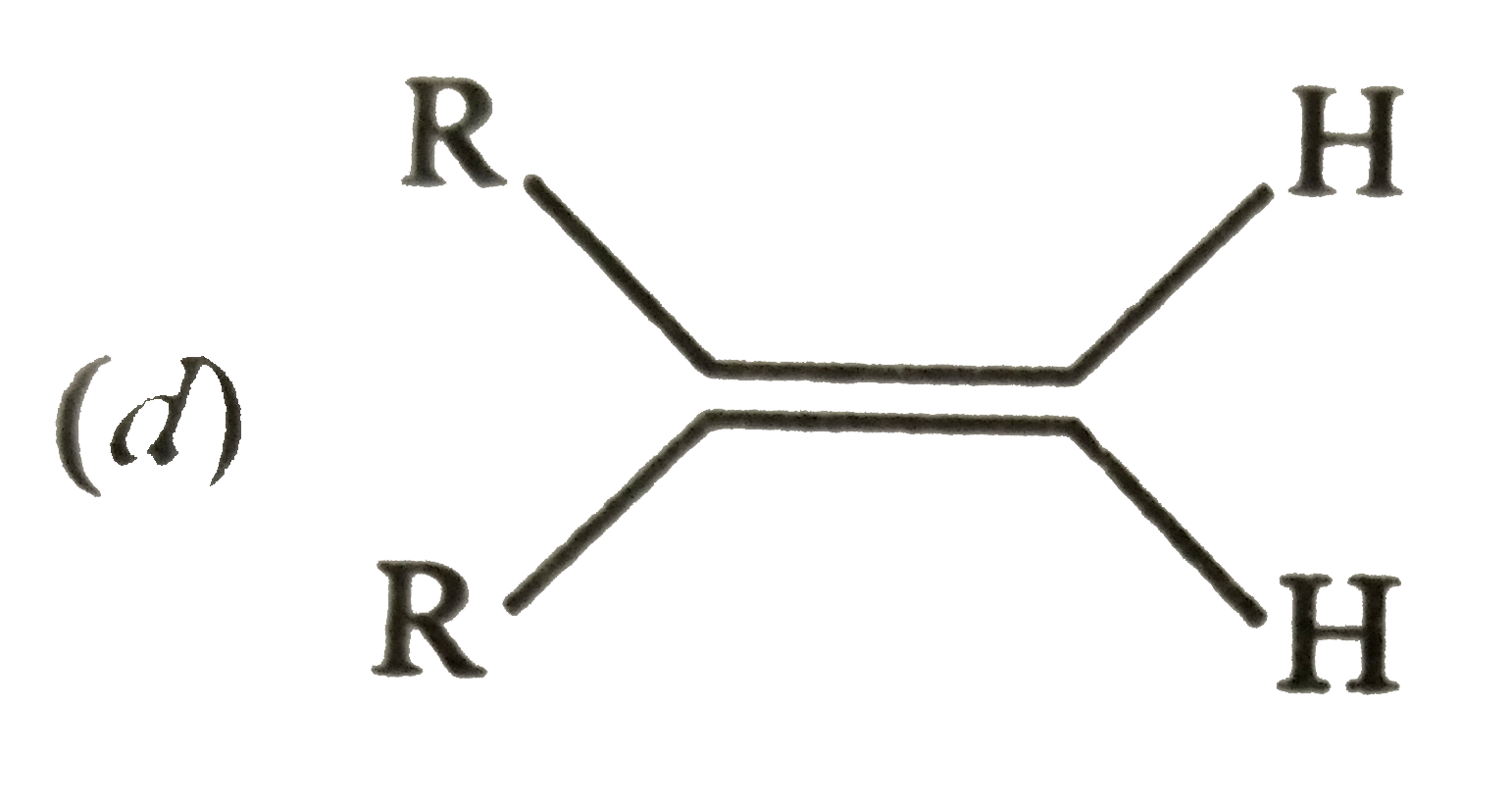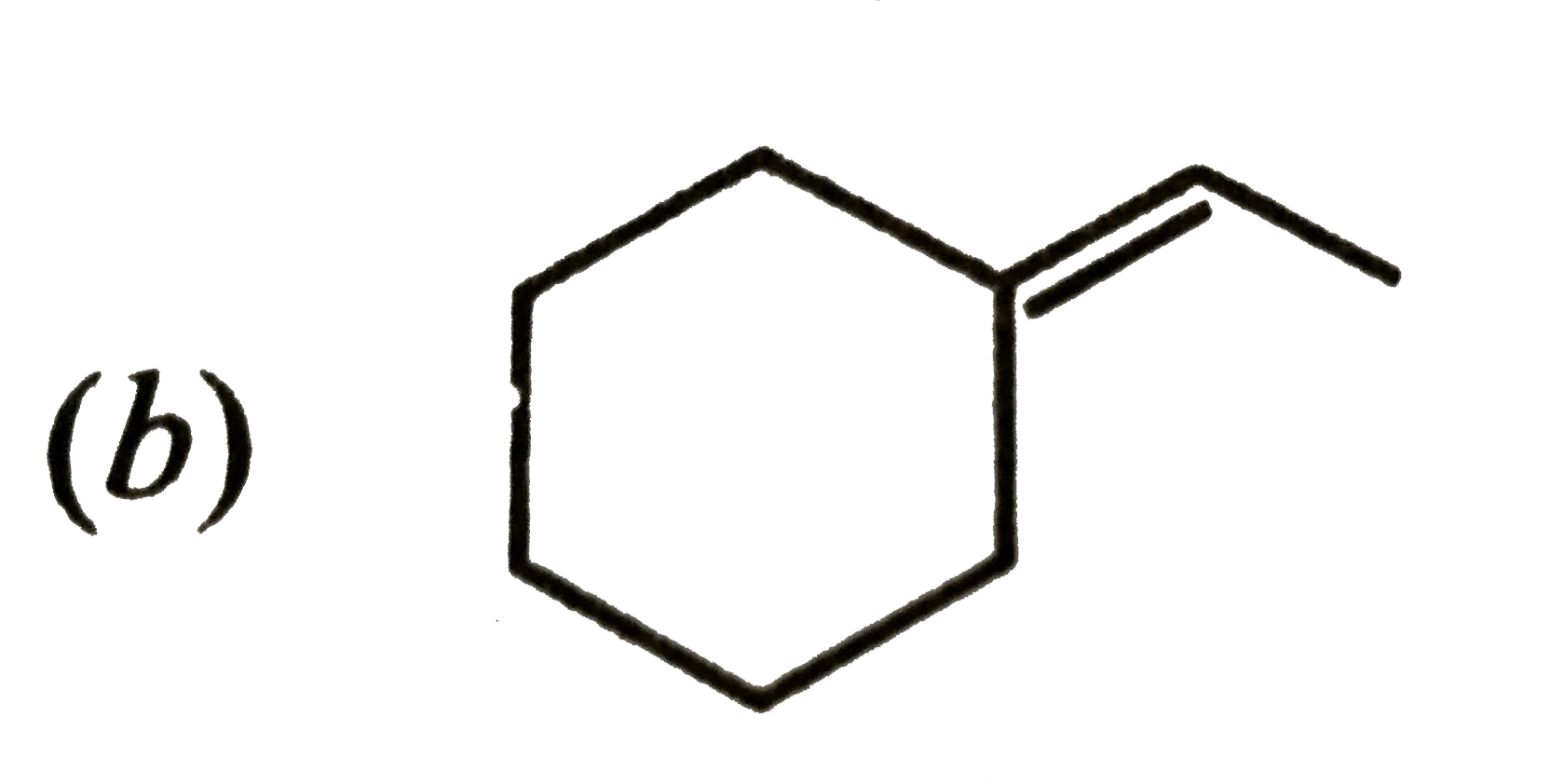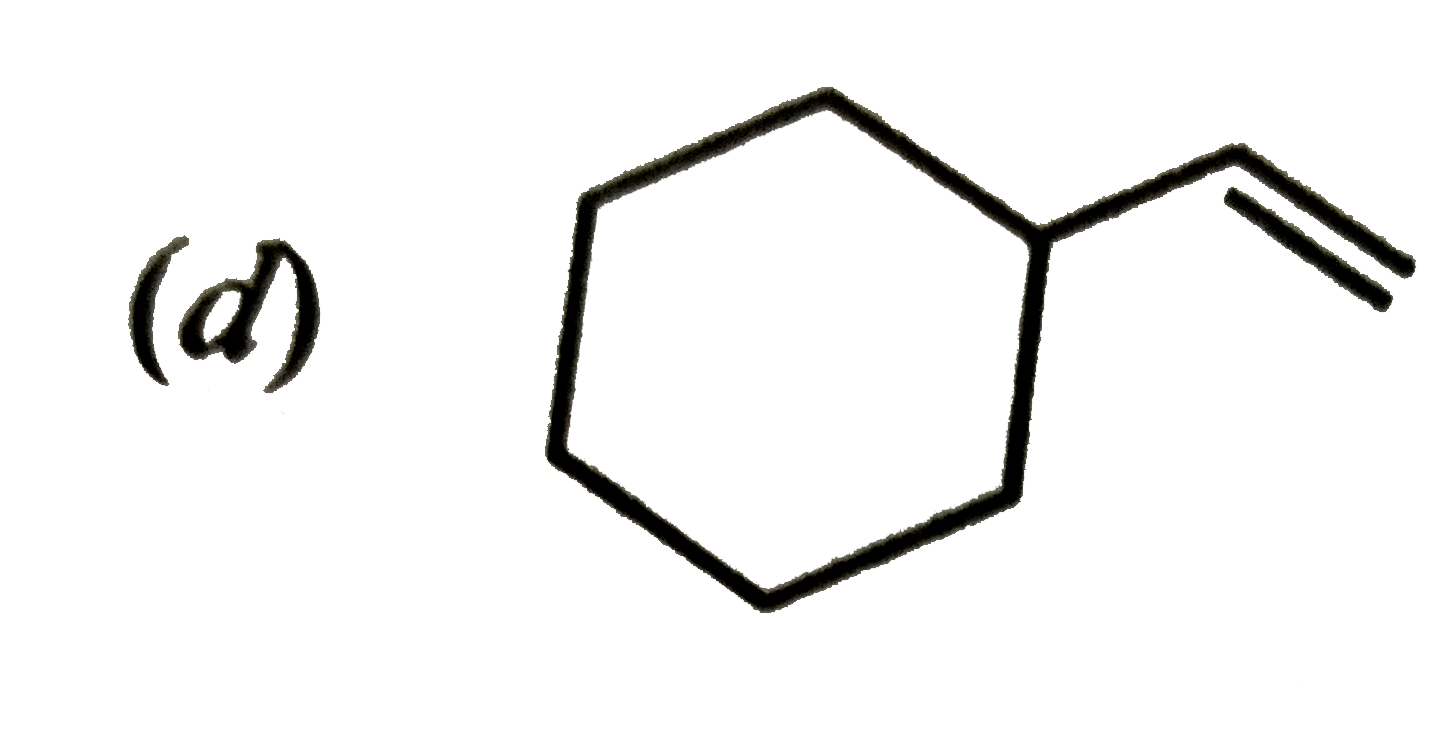Catalytic hydrogenation involves addition of hydrogen to a gt C = Clt or -C C- bond in presence of a metal catalyst such as Ni, Pt, Pd, etc. These are called heterogeneous catalysts. Both and alkene/alkyne get adsorbed on the surface of the metal , and syn-addition of hydrogen atoms takes place. The relative rates of hydrogenation follows the order:
If sodium or lithium in liquid ammonia is used, anti-addition of H-atoms occurs across bond. These reducing agents can also be used to reduce double bonds of benzene rings and conjugated dienes but not of isolated dienes.
Which of the following alkenes will react most readily with under catalytic hydrogeneration conditions ?




The correct Answer is:B
To determine which alkene will react most readily with H₂ under catalytic hydrogenation conditions, we need to analyze the structure of the alkenes provided in the options. The key factors influencing the rate of hydrogenation include steric hindrance and the degree of substitution of the double bond.
1. Understanding the Reaction: Catalytic hydrogenation involves the addition of hydrogen (H₂) across a double bond (C=C) in the presence of a metal catalyst (like Ni, Pt, or Pd). The reaction occurs via syn-addition, meaning both hydrogen atoms add to the same side of the double bond.
2. Identify the Alkene Structures: Look at the provided alkene options. The structure of each alkene will determine how easily it can undergo hydrogenation.
3. Evaluate Steric Hindrance:
- Alkenes with fewer bulky groups (R groups) attached to the double bond will have less steric hindrance and will react more readily.
- For example, a terminal alkene (like propene) will generally react faster than a more substituted alkene (like 2-butene) because the terminal alkene has fewer substituents around the double bond.
4. Degree of Substitution:
- The rate of hydrogenation decreases with an increase in the number of substituents on the double bond.
- For example, a monosubstituted alkene will react faster than a disubstituted or trisubstituted alkene.
5. Comparing the Options:
- If the options include alkenes such as ethene (no substituents), propene (one substituent), and 2-butene (two substituents), you would expect ethene to react the fastest, followed by propene, and then 2-butene.
- If there are more complex alkenes with multiple substituents, they will generally be slower to react.
6. Conclusion: Based on the analysis of steric hindrance and degree of substitution, the alkene that is least substituted (or has the least steric hindrance) will react most readily with H₂ under catalytic hydrogenation conditions.
Final Answer:
The alkene that will react most readily with H₂ under catalytic hydrogenation conditions is the one with the least steric hindrance and the lowest degree of substitution.
---
- Alkenes with fewer bulky groups (R groups) attached to the double bond will have less steric hindrance and will react more readily.
- For example, a terminal alkene (like propene) will generally react faster than a more substituted alkene (like 2-butene) because the terminal alkene has fewer substituents around the double bond.
- The rate of hydrogenation decreases with an increase in the number of substituents on the double bond.
- For example, a monosubstituted alkene will react faster than a disubstituted or trisubstituted alkene.
- If the options include alkenes such as ethene (no substituents), propene (one substituent), and 2-butene (two substituents), you would expect ethene to react the fastest, followed by propene, and then 2-butene.
- If there are more complex alkenes with multiple substituents, they will generally be slower to react.
The alkene that will react most readily with H₂ under catalytic hydrogenation conditions is the one with the least steric hindrance and the lowest degree of substitution.
Topper's Solved these Questions
- HYDROCARBONSBook:PRADEEPChapter:HYDROCARBONSExercise:Competition Focus (JEE(main and advanced)/Medical Entrance) IV. MATCHING TYPE QUESTIONS
Explore 3 Videos
- HYDROCARBONSBook:PRADEEPChapter:HYDROCARBONSExercise:Competition Focus (JEE(main and advanced)/Medical Entrance) V. MATRIX-MATCH TYPE QUESTIONS
Explore 1 Video
- HYDROCARBONSBook:PRADEEPChapter:HYDROCARBONSExercise:Competition Focus (JEE(main and advanced)/Medical Entrance) II. MULTIPLE CHOICE
Explore 14 Videos
- EQUILIBRIUM IN PHYSICAL AND CHEMICAL PROCESSESBook:PRADEEPChapter:EQUILIBRIUM IN PHYSICAL AND CHEMICAL PROCESSESExercise:Competition Focus (Jee(Main and advanced)/Medical Entrance) VIII. ASSERTION - REASON TYPE QUESTIONS (TYPE - II)
Explore 10 Videos
- HYDROGEN Book:PRADEEPChapter:HYDROGEN Exercise:COMPETITION FOCUS (Assertion-Reason Type Questions) Type 2
Explore 15 Videos
Similar Questions
Knowledge Check
Catalytic hydrogenation involves addition of hydrogen to a gt C = Clt or -C ≡ C- bond in presence of a metal catalyst such as Ni, Pt, Pd, etc. These are called heterogeneous catalysts. Both H2 and alkene/alkyne get adsorbed on the surface of the metal , and syn-addition of hydrogen atoms takes place. The relative rates of hydrogenation follows the order:
−C≡C−>>C=C<>C=o<C6H6
If sodium or lithium in liquid ammonia is used, anti-addition of H-atoms occurs across −C≡C−bond. These reducing agents can also be used to reduce double bonds of benzene rings and conjugated dienes but not of isolated dienes.
Which of the following functional groups is most easily reduced.Agt C=OBgt C =C ltC−C≡C−DC6H6Catalytic hydrogenation involves addition of hydrogen to a C=Cor−C≡C− bond in presence of a metal catalyst such as Ni, Pt, Pd, etc. These are called heterogeneous catalysts. Both H2 and alkene/alkyne get adsorbed on the surface of the metal , and syn-addition of hydrogen atoms takes place. The relative rates of hydrogenation follows the order:
−C≡C−>C=C>C=O>C6H6
If sodium or lithium in liquid ammonia is used, anti-addition of H-atoms occurs across −C≡C−bond. These reducing agents can also be used to reduce double bonds of benzene rings and conjugated dienes but not of isolated dienes.
The catalytic hydrogenation of which of the following alkenes is most exothermic ?A B
B C
C D
D
Catalytic hydrogenation involves addition of hydrogen to a C=Cor−C≡C−bond in presence of a metal catalyst such as Ni, Pt, Pd, etc. These are called heterogeneous catalysts. Both H2 and alkene/alkyne get adsorbed on the surface of the metal , and syn-addition of hydrogen atoms takes place. The relative rates of hydrogenation follows the order:
−C≡C−>>C=C<>C=o<C6H6
If sodium or lithium in liquid ammonia is used, anti-addition of H-atoms occurs across −C≡C−bond. These reducing agents can also be used to reduce double bonds of benzene rings and conjugated dienes but not of isolated dienes.
[A]Lindlar's←−−−−CatalystCH3−C≡C−CH3 Na in−−−−→liq.NH3[B]
[A] and [ B] are respectivelyAcis, trans-2-buteneBboth trans-2-buteneCtrans,cis-2-buteneDboth cis-2-butene
Dihydrogen gas adds to alkenes and alkynes in the presence of finely divided catalysts like Pt,Pd,orNi to form alkanes. This process is called
View SolutionWhich of the following reagent will convert >CO group into >C(C6H5)OH ?
View SolutionReduction of H3C−NC with hydrogen in the presence of Ni/Pt catalyst gives
View SolutionPhenol on hydrogenation in the presence of nickel catalyst at 160∘C gives
View SolutionIn >C=O group sigma bond is formed by
View Solution


